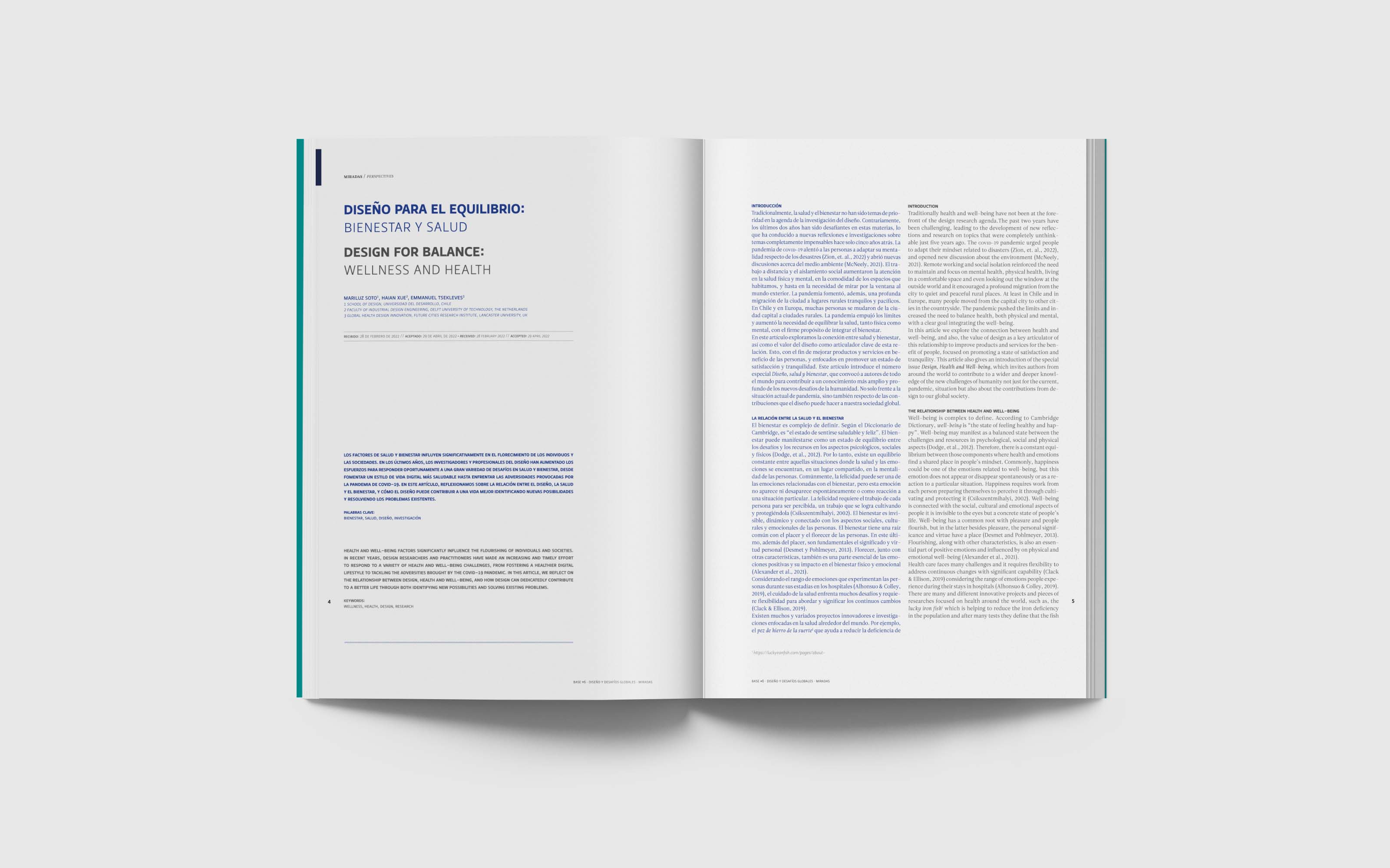Design for balance: wellness and health
Main Article Content
Abstract
Health and well-being are areas that undoubtedly have a significant relevance in people's lives. Design from research and practice has the challenge of responding to the needs and challenges that emerge on a daily basis and those that generate crises worldwide, such as the COVID-19 pandemic. Therefore, health has the ability to destabilize people's personal lives and currently the entire world. This article explores the connections between design, health and well-being, emphasizing reflections that specifically involve people's quality of life. This article proposes placing design in an active role in the creation of solutions and opportunities that benefit people in those aspects that largely determine the perception of well-being. As a consequence, the design could be considered the balance between both concepts, aiming to benefit human life.
Article Details
References
Alhonsuo, M. and Colley, A., (2019) Designing New Hospitals - Who Cares About the Patients?. MuC'19: Proceedings of Mensch und Computer 2019. September 2019, p. 725–729 https://doi.org/10.1145/3340764.3344898
Alhonsuo, M., Hookway, S., Sarantou, M., Miettinen, S., & Motus, M. (2020). Healthcare design sprints: What can be changed and achieved in five days? In S. Boess, M. Cheung, & R. Cain (Eds.), Proceedings of DRS2020: Volume 1: Synergy Situations (pp. 975-991). Design Research Society. Proceedings of DRS Vol. 2020 No. 1 https://doi.org/10.21606/drs.2020.231
Beddington, J., Cooper, C., Field, J., Goswami, U., Huppert, F., Jenkins, R., Thomas, S. (2008) The mental wealth of nations. Nature 455, 1057–1060. https://doi.org/10.1038/4551057a
Calvo, R. A., & Peters, D. (2014). Positive Computing: Technology for Wellbeing and Human Potential. Cambridge, Massachusetts: MIT Press.
Clack, L. A., & Ellison, R. L. (2019). Innovation in service design thinking. In M. A. Pfannstiel &
C. Rasche (Eds.), Service design and service thinking in healthcare and hospital management: Theory, concepts, practice.
Cooper, C.L. (2014) Introduction to Wellbeing: A Complete Reference Guide. In Rachel Cooper, Elizabeth Burton, Cary Cooper (Eds) Wellbeing: A Complete Reference Guide, Wellbeing and the Environment. John Wiley & Sons
Csikszentmihalyi, M. (2002). Flow: The Classic work on how to achieve happiness. Rider Books
Deci, E. L., & Ryan, R. M. (2002). Overview of self-determination theory: An organismic dialectical perspective. In E. L. Deci & R. M. Ryan (Eds.), Handbook of self-determination research (pp. 3-33). Rochester, NY: University of Rochester Press.
Demirci, K., Akgönül, M., & Akpinar, A. (2015). Relationship of smartphone use severity with sleep quality, depression, and anxiety in university students. Journal of Behavioral Addictions, 4(2), 85-92.
Desmet, P. M. A. (2015). Design for mood: Twenty activity-based opportunities to design for mood regulation. International Journal of Design, 9(2), 1-19.
Desmet, P. M. A., & Fokkinga, S. F. (2020). Beyond Maslow’s pyramid: Introducing a typology of thirteen fundamental needs for human-centered design. Multimodal Technologies and Interaction., 4(3), 38. doi:https://doi.org/10.3390/mti4030038
Desmet, P. M. A., & Pohlmeyer, A. E. (2013). Positive design: An introduction to design for subjective well-being. International Journal of Design, 7(3), 5-19.
Dodge, R., Daly, A., Huyton, J., & Sanders, L. (2012). The challenge of defining wellbeing. International Journal of Wellbeing, 2(3), 222-235. doi:10.5502/ijw.v2i3.4
Donetto, S., Pierri, P., Tsianakas, V. & Robert, G. (2015) Experience-based Co-design and Healthcare Improvement: Realizing Participatory Design in the Public Sector,The Design Journal, 18:2, 227-248
Hassenzahl, M., Diefenbach, S., & Göritz, A. (2010). Needs, affect, and interactive products – Facets of user experience. Interacting with Computers, 22(5), 353-362. doi:10.1016/j.intcom.2010.04.002
Hassenzahl, M., Eckoldt, K., Diefenbach, S., Laschke, M., Lenz, E., & Kim, J. (2013). Designing moments of meaning and pleasure: Experience design and happiness. International Journal of Design, 7(3), 21-31.
McNeely J. A. (2021). Nature and COVID-19: The pandemic, the environment, and the way ahead. Ambio, 50(4), 767–781. https://doi.org/10.1007/s13280-020-01447-0
Noël, G. (2017) Health Design: Mapping current situations, envisioning next steps, The Design Journal, 20:sup1, S2304-S2
Pohlmeyer, A. E. (2017). How design can (not) support human flourishing. In C. Proctor (Ed.), Positive Psychology Interventions in Practice (pp. 235-255). Cham: Springer.
Pohlmeyer, A. E., & Desmet, P. M. A. (2017). From good to the greater good. In J. Chapman (Ed.), Routledge Handbook of Sustainable Product Design. New York: Routledge.
Robert, G., & Macdonald, A.S. (2017) Co-design, organizational creativity and quality improvement in the healthcare sector: ‘Designerly’ or ‘design-like’? In Sangiorgi, D., & Prendiville, A. (Eds) Designing for Service. Bloomsbury
Roumani, Nadia (2020) Unlocking the power of design for the social sector. Stanford University https://dschool.stanford.edu/news-events/unlocking-the-power-of-design-for-the-social-sector-a-human-centered-systems-minded-and-strategy-aligned-design-approach-for-social-sector-leaders
Seligman, M. E. P. (2002). Authentic happiness: Using the new positive psychology to realize your potential for lasting fulfillment. New York: Free Press.
Seligman, M. E. P. (2011). Flourish : A visionary new understanding of happiness and well-being. New York: Free Press.
Soga, M., Evans M. J., Cox, D. T. C., & Gaston, K. J. (2021) Impacts of the COVID-19 pandemic on human–nature interactions: Pathways, evidence and implications. People and Nature, 3(3), p. 518-527. https://doi.org/10.1002/pan3.10201
Wiese, L., Pohlmeyer, A. E., & Hekkert, P. (2020). Design for sustained wellbeing through positive activities—a multi-stage framework. Multimodal Technologies and Interaction, 4(4), 71.
Xue, H., Desmet, P. M. A., & Fokkinga, S. F. (2020). Mood granularity for design: Introducing a holistic typology of 20 mood states. International Journal of Design, 14(1), 1-18.
Yoon, J., Li, S., & Hao, Y. (2022). Design-mediated positive emotion regulation: The development of an interactive device that supports daily practice of positive mental time traveling. International Journal of Human–Computer Interaction, 38(5), 432-446.
Zion, S.R., Kengthsagn, L., Horii, R., Leibowitz, K., Heathcote, L.C., and Crum, A.J. (2022) Making sense of a pandemic: Mindsets influence emotions, behaviors, heath, and wellbeing during the COVID-19 pandemic. Social Science & Medicine. Vol.301 https://doi.org/10.1016/j.socscimed.2022.114889


